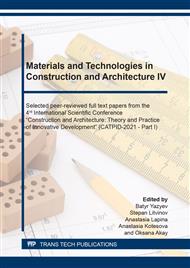p.109
p.115
p.121
p.127
p.133
p.141
p.149
p.155
p.163
Fire-Retardant Plastering Mortars Based on Exfoliated Vermiculite and Volcanic Ash
Abstract:
The research results on the development of fire-retardant composite cement mortar mixtures on exfoliated vermiculite and volcanic ash with the use of a multifunctional additive are presented D-5. Compositions of fire-retardant composite mortars, which make it possible to significantly improve the physical and mechanical properties of mortar mixtures and mortars, are proposed. Introduction of a multifunctional supplement D-5 in mortar mixtures makes it possible to improve the composite mortar mixtures properties and improve the solution characteristics. Replacement of finely dispersed fraction of exfoliated vermiculite d<0,63 mm volcanic ash by volume in mortar mixtures does not cause a noticeable increase in the solution density, while their strength characteristics increase. The developed composite mortar mixtures meet the requirements of GOST 28013–98 and have a low-cost price due to volcanic ash use.
Info:
Periodical:
Pages:
133-139
Citation:
Online since:
August 2021
Authors:
Price:
Сopyright:
© 2021 Trans Tech Publications Ltd. All Rights Reserved
Share:
Citation:


